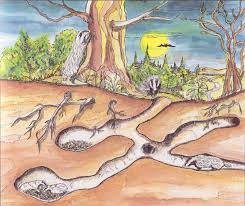Predators (Carnivora) are hunters or scavengers that eat (mostly) meat. We won’t mention the predatory fish, and limit ourselves to a few (sometimes putative) predators and prey birds that we prefer not to see close to our chickens.
Of each species we describe as much as possible
view: color, length, height, weight, tail, typical features
reproduction (time, farrowing, offspring), usually in February-May
habitat, den, burrow or nest, twilight or nocturnal
hibernation, winter stock
menu
track, excrement, prey remains
how to repel or deter. This often arises habituation. So you have to change the method (sound, image, location, color, size, quantity) regularly!
Three groups are discussed:
 Mustelids (Mustelidae) are a family of territorial carnivores (Carnivora) with large sharp canines and premolars, a long body and short legs. Most species are good climbers and produce a strong smell of anal glands. They are primarily nocturnal. Males are generally larger than females.
Mustelids (Mustelidae) are a family of territorial carnivores (Carnivora) with large sharp canines and premolars, a long body and short legs. Most species are good climbers and produce a strong smell of anal glands. They are primarily nocturnal. Males are generally larger than females.
Some species have a beautiful skin and therefore are bred or hunted.
We know here badger, otter, weasel, polecat, ferret, mink and stone- andpine marten.
Crows: magpie, raven, rook, jay, crow
Raptors: hawk, hen harrier, marsh harrier, honey buzzard, buzzard, hawk. Females areusually largerand more colorful.
Raptors capture their prey during the day, and are divided into two main groups:
the eagle-like and falcon -like.
Eagle -like are "catch killers": with their claws they grab the prey and kill them instantly with their long nails.
The falcon -like use their claws only to grab the prey, but they kill with their beaks. They have a "tomial tooth", a notch in the upper mandible that by leveraging also strong (neck) tendons of prey can bite through.
Falcons pounce from a dive on their (flying) prey, they 'hit' in the air. (These soaring raptors we call therefore in Dutch sometimes punch birds too.)
Hawks, sparrow hawks and buzzards are birds of prey who beat their prey at the ground.
Some concepts that regularly come back:
A burrow is a underground by small mammals excavated stay to shelter, sleep, eat and give birth. She has multiple flight holes or entraces. Foxes sometimes conquer the burrow of another animal. Other residents are badger, otter, beaver, rabbit.
Culture follower
Mice, stone martens, sparrows... Is a region cultivated by man, they follow soon to enjoy along our surplus, remnants, stocks, stables etc.
Surplus killing
Sometimes a pigeon or hen house is massacred, while only one or two animals are taken. Through their survival instinct "grab what you can" foxes and skunks do that. In nature, it sometimes helps to grab 2 instead of 1 prey. The others escape anyway. In a cage it seems pointless, but their instinct is stronger than our logic.
Latrine
Permanent place where e.g. martens leave their droppings. Outdoor toilet.
Mast year
Oak and beech make not every year as much seed like birch or pine do. Each nine years the weather conditions seem to be favorable, the trees create many reserves and they have abundant seeds. Foresters call this a mast year. In the Middle Ages, the pigs were (branded) in autumn forest driven and "masted fat" especially with acorns. Too squirrels, jays... take advantage of this, but also their predators (mustelids...). Due to climate change, the periods nowadays seem shorter than 9 years.
The mating season is that particular period of the year when driven by hormonal changes mating and reproduction takes place. Testosterone makes males more aggressive. The mating season usually falls in the spring, for some species in the fall. This seems to depend on the gestation period, so that offspring are born in spring. Then there is enough food. Each species has its own rituals and (seduction) techniques. There are several names which are sometimes tied to a particular species. Humans and apes have no rutting season, but instead a menstrual cycle.
Rut, rutting season (deer)
Spawning (fish)
Breeding season (rabbit, hare,…)
Courtship (birds, mating dance)
Predator: hunter, beast of prey, hunting prey to kill them.
Carnivore: meat eater. Raptor, pike, dragonfly, badger, wolf
Omnivore: all eater, eating both plant and animal foods. Pig, man, bear,
Herbivore: plant eater. Often herbivores are ruminants. Deer, squirrel, goose, caterpillar
Insectivore: eat insects. Mole, hedgehog
A territory is the terrain defended against conspecifics to search for food and care for the offspring. It is usually marked with a scent mark: urine, latrines, droppings.
It is obtained or retained by fighting and threatening. Outside the territory dominates the tendency to flee.
In (mostly solitary) Mustelidae the territory of one male will overlap with that of a number of females. How big the habitat is depends mainly on the amount of available food.
The fox is in <Agricilture>
Rat and mouse under <Wild>
